To maintain a colorful garden, Long Purple Leaves Plants can be planted, which in some cases are edible, medicinal or simply decorative. They provide great showiness when growing in sunny places as well as when they are in semi-shaded areas receiving the necessary care. We invite you to continue reading this article so that you know the variety of vegetation that exists with this violet foliage.
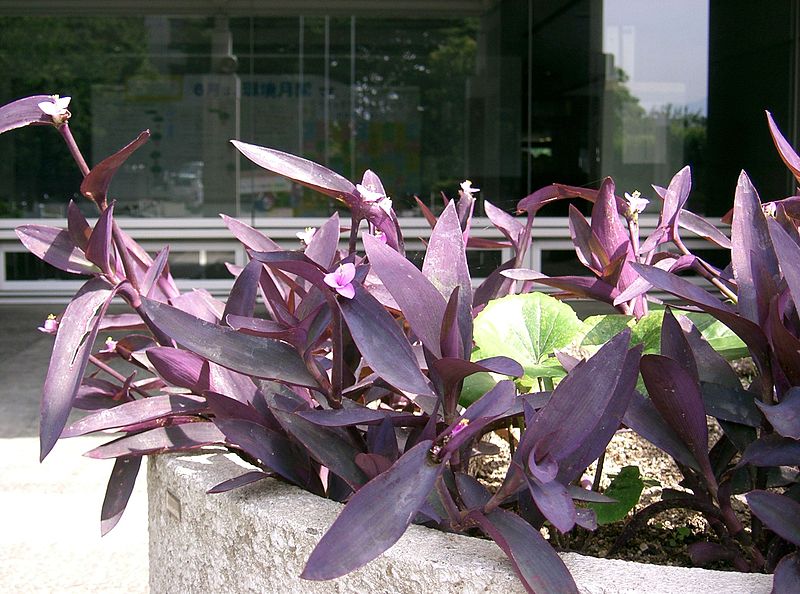
Long Purple Leaved Plants
The purple foliage of plants is due to a higher concentration of a coloring substance present in the vacuoles of plant cells known as anthocyanin, which predominates over green pigmentation, which through a process breaks down to reveal additional shades, thus appearing the beautiful nuances of the existing vegetation, including purple, which when combined with other range of plantations generates a great contrast that makes gardens or any space in which it is incorporated as decorative natural elements shine.
General Tips on Purple Long Leaf Plants
For the correct maintenance of plants that have foliage of this tone, it is advisable to pay attention to the light factor, since most plants with purple leaves will require light to preserve their color and compact shape. If they are outdoors, they must be placed where indirect sunlight reaches them, and if they are indoors, they must be near a window so that they receive bright light, in any case if it is a somewhat closed space. a grow light can be used and set on an outlet timer.
Regarding irrigation, these plants require that it be moderate, that is, it cannot be excessive or insufficient so as not to saturate or dry it, for which a water meter for plants can be used, especially when they are indoors and it can also be ensure additional humidity by placing a humidifier near the plants during the winter season. In addition, another of the conditions is that they require a soil that must be treated with mineral fertilizers during the spring and summer months.
Variety of plants with this hue
There is a wide range of plants that are distinguished by having their foliage pigmented in a purple tone, which require optimal conditions in terms of water, light, humidity, among others, so that they can grow healthy and keep their color all the time regardless. from the place of cultivation, hence we are interested in describing below a sample of the great variety of plants with long purple leaves that nature provides with its maximum splendor.
persian shield (Strobilanthes dyeranus)
They are beautiful plants with long purple leaves, with flowers that combine purple and silver, they stand out in any container as they reach almost a meter in height. Also called royal purple plant, when grown in partial shade it will collect light and reflect it off its leaves, but if kept indoors it will need bright light to maintain its purple color. It grows well in the neutral range of soil pH and can tolerate slightly acidic soil. The less water it receives, the more shade it will need.
Requiring warm temperatures above 15 degrees Celsius and moist air, they are usually most often grown indoors or as a summer annual in cooler climates. If planted in rich soil with high moisture, the Persian shield will only need a light feeding at the beginning of the season and again in mid-summer. Indoors in a container, keep the plant at a manageable size rather than letting it grow to full capacity. The best way to do this is to transplant the youngest plants each year until they reach full size, then transplant them every two years.
When you want more plants with lovely purple foliage, you can do so from seeds or cuttings, but keep in mind that the seeds require somewhat warm conditions between 12 and 18 degrees to germinate, while the cuttings will need to come from soft wood and apply a little heat on the bottom to prevent rotting before they take root. The best seasons for plant reproduction is during spring and early summer.
Since Persian shield is grown for its foliage and the flowers are not particularly showy, many gardeners like to frequently remove the leaves to create a bushier plant and thus control its growth. In this regard, it is advisable not to eliminate the withered leaves that develop immediately after flowering and although they seem sad, what they manifest is their state of winter inactivity and is going through a natural lethargy until it reactivates and grows again in the spring.
Wandering Jew (Tradescantia Zebrina)
They are tropical perennials that are grown on the ground in a garden or in hanging containers to facilitate their growth in the form of a vine, they can also be located near sunny windows. It is important to know that they are not cold tolerant and will die with the first hard frost if left outdoors, however they can be moved indoors for winter care. It is a variety that has leaves with olive and silver markings on the upper part and a dark purple color on the lower part, but there are other variants that show a purple color on both leaf surfaces.
Tradescantia thrives well in medium to bright light soils. It is an easy plant to grow from stem cuttings submerged in water or stuck in moist potting soil. It is recommended that they be helped to climb by supporting them during their growth and allowing the soil to dry out between watering periods, keeping it evenly moist at all times, which can be verified using an indoor/outdoor moisture meter and sensor. When the humidity is too low, the leaves start to turn brown and die.
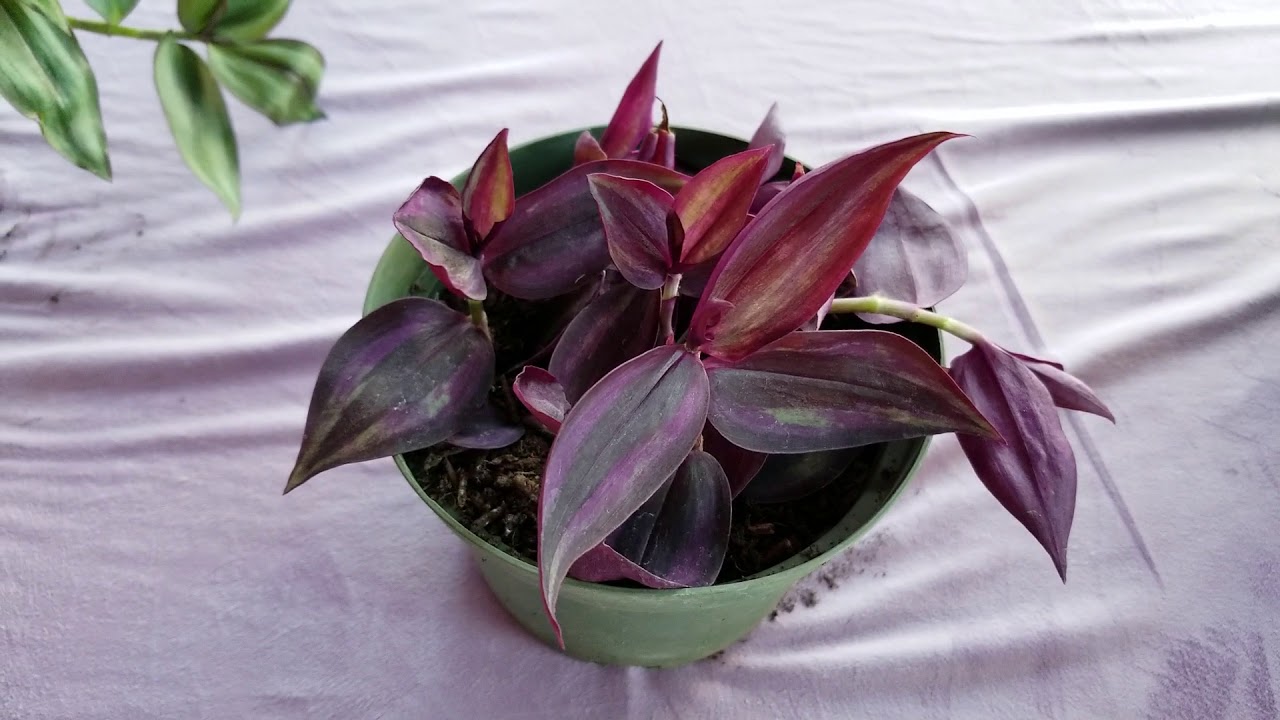
When they don't get enough light, the hue of their foliage fades. If you choose to move it outside during the summer, be sure to keep it in partial shade where it will be protected from direct sunlight. On the other hand, this type of plant only needs to be fertilized from spring to summer and it is important to know that insects are not usually a problem when growing wandering beans outdoors. But mites, aphids and fungus gnats can damage them in domestic spaces and to recover the infected purple leaves you have to use a natural pesticide.
cercis canadensis
It is considered a small multi-stemmed shrub, set at the back of a border or in a prominent position in the garden. In spring, its branches produce bright pink flower clusters, while its leaves emerge a brilliant reddish-purple. In summer these leaves darken to a beautiful burgundy color, before turning a striking mix of gold, orange and crimson in autumn. It grows in sun or partial shade in any well-drained soil, reaching 8 meters in height within 20 years.
The leaves of this tree are alternate and simple, with entire edges less than 12 centimeters in length, and are broad, slender, and may have a slightly downy underside. Dark green above, in autumn they turn a bright, light yellow. In addition, it has a graceful irregular branching pattern, due to which its short trunk often splits close to the ground. The slender branches arch outward, giving the tree a dense, rounded shape. The bark is dark, reddish brown, smooth, later scaly with somewhat obvious ridges, sometimes with brown spots.
The fruits are flattened, dry, brown and measure about 10 centimeters, inside which they keep flat, elliptical seeds of about 5 or 6 millimeters, which ripen from mid-summer to mid-autumn. Specimens of these long, purple-leaved plants are easy to grow and are more cold tolerant than similar species. It is usually propagated by seeds sown half a centimeter deep or by rooted cuttings.
It is important to know that planting must be done in deep soil so that it can develop a long taproot within the first three years after propagation under normal growing conditions. Although tolerant of dry spells, Cercis canadensis does best when watered regularly during the dry summer season. Pruning is recommended to help it develop a strong structure, which can be done in late winter or early spring by removing any crossing branches.
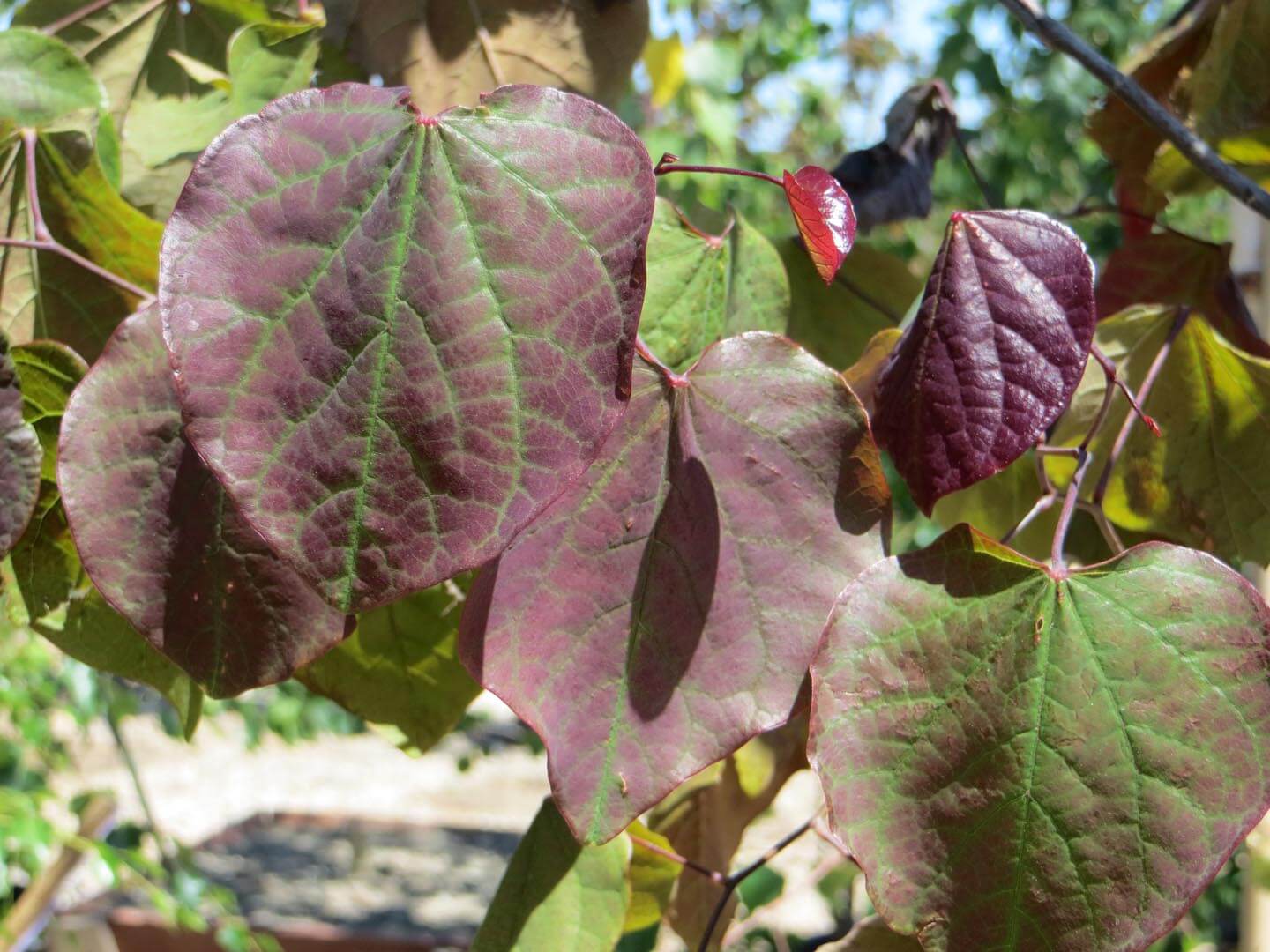
sand cherry
Considered a medium-sized shrub, it has striking purple foliage, especially for decorating gardens from early spring to autumn, it is native to North America, it is characterized by rapid growth that varies from 1 to 3 meters in height. They can be planted in early spring and are relatively easy to grow, adapting well to a variety of soil and sun conditions. When the plant is young, it is oval in shape and will arch and open more from the center when it reaches maturity.
This is one of the long purple leafed plants that blooms each spring after the foliage emerges. The light pink and white flowers are soon replaced by black or purple fruits in mid-summer. The fruits are an important food source for many birds, including robins and cardinals. While purpleleaf sand cherry stems will be reddish-brown to dark gray in color and tend to ooze sap, a trait that is particularly noticeable if the plant develops fissure.
Soil drainage is important because their roots live near the surface and are susceptible to rot. Also, it needs to be watered regularly as it is also not drought tolerant. One watering per week is usually enough, but you may need more if you've recently transplanted, are going through a period of hot, dry weather, or are in their first growing season. On the other hand, it can be said to be all-weather resistant, able to withstand a wide range of temperatures in summer and winter, although plants grown in cooler climates may be smaller and produce fewer flowers.
In spring additional nutrients can be supplied through fertilization. Pruning should be done as needed after the flowers arrive in spring to maintain a tighter oval shape, starting by trimming the oldest stems first, removing about a third of the existing growth and leaving a few inches. of the trunk exposed at the base. Always remove branches that are damaged. If you wish, you can carry out a stricter pruning to design an ornamental hedge.
The plant is susceptible to pests such as Japanese beetles, fall grubs, aphids, mealybugs, and caterpillars, which can cause significant damage to its foliage, including holes and browning or wilting of purple leaves. They can also contract several diseases, including honey fungus, verticillium wilt, black knot, cankers, powdery mildew, leaf spot, and bacterial leaf burn. In addition, its branches are prone to frost. Both problems with pests and diseases can cause the plant to shorten its life cycle, so it is important to act immediately to combat any infection.

sweet carolina creeper
Also called the sweet potato vine, it grows very well outdoors or indoors, highly sought after for being suitable for container gardens, borders, flower beds and landscapes. The plant is prized primarily for its glossy foliage that is available in different colors, including purple. It is a plant that does not flower, but only with its extraordinary foliage it can be enjoyed throughout the year without having to wait for the flowers to appear. Sweet potato vine does best in moist, well-drained soil, plus this is a variety that is quite flexible with regard to light requirements.
These types of ornamental plants usually grow in the sun or in partial shade, however, the sunnier they are, the better the coloration of their leaves. They are drought tolerant, although they will grow vigorously with frequent watering, be sure to keep the soil constantly moist, but not too much as the leaves may wilt. Fertilizing sweet potato vines is usually optional and will depend on how big you want them to grow, however a weekly feeding during the growing season will be adequate, but given their naturally robust habit, your additional nutrient supply may also increase. the need to cut them.
These long purple leafy plants are easy to grow from existing plants. Just separate a branch with several leaf nodes and remove them from the bottom a few inches and soak the stem in water for several days until the roots come out. This is a good way to overwinter sweet potato vines because they will last all winter in water and are ready to plant in the spring. Another way to propagate is to use the tubers after digging them up before the first frost, letting them dry, and storing them over the winter in peat or vermiculum in a cool, dry place, such as a cellar.
Pests that feed on these long purple-leaved plants include the golden tortoise beetle that bores into their leaves, they can also be attacked by leaf-chewing caterpillars and the sweet potato whitefly that can drain nutrients from the plant. and slow down its growth. These vines are also prone to foliar fungus, especially if planted in the same spot over multiple seasons, so it is advisable to avoid this problem by varying planting spacing between seasons and applying natural insecticides as soon as you notice them. damage.
Japanese barberry (Berberis thunbergii)
Plants belonging to this genus have thorns and are tolerant and hardy by nature. Its reddish-purple leaves qualify as deciduous, with some variation during development, so the leaves on young shoots are more pinkish, giving a lovely effect when bushes are fringed by fuzzy new growth. They also bear bright yellow flowers in the summer and bright red berries in the fall. It grows well in all soils and its coloration stands out best in full sun. They are also used to cut topiary shapes in special landscaping designs.

These shrubs have a rounded habit, reach a height of five feet, and pale yellow flowers that bloom in mid-spring. They also have sharp spines and elongated red berries that endure well through the colder months and are therefore valued for the winter interest they provide. This shrub grows easily in medium soils. It can tolerate a variety of soil conditions, as long as there is good drainage. Soggy soil can lead to root rot.
In general, it is not necessary to fertilize Japanese barberries unless you have very poor soil. To improve the health and vigor of the plants, you can fertilize them in late winter or early spring before flowering begins with a slow-release shrub fertilizer. On the other hand, it doesn't require constant cutting either, unless you want to remove damaged or diseased parts as needed, or simply sculpt. This more extensive pruning should be done after the shrub blooms in spring or early summer.
To complete the general description of this plant, it can be noted that it has among its varieties the so-called Crimson Pygmy, which stands out for being a small tree up to one meter high and having showy reddish-purple foliage. There is also the Concorde type, with which this compact, rounded shrub is identified, which only reaches about 60 centimeters in height and sports dark purple foliage that becomes even more intense in the months of September to December.
Smoke Shrub (Cotinus Royal Purple)
The deep purple leaves of this smoke shrub will offset your borders, gardens, or containers with a dark background. The vigorous shrub produces leaves that will be larger if heavily pruned each year, especially in the spring. Cotins are tolerant plants that do well in sun or dappled shade and in most soils, but their color is brightest when grown in a sunny location. It can reach 8 meters in height. During the summer months, these plants are covered in a mist of feathery flowers, giving them their name.
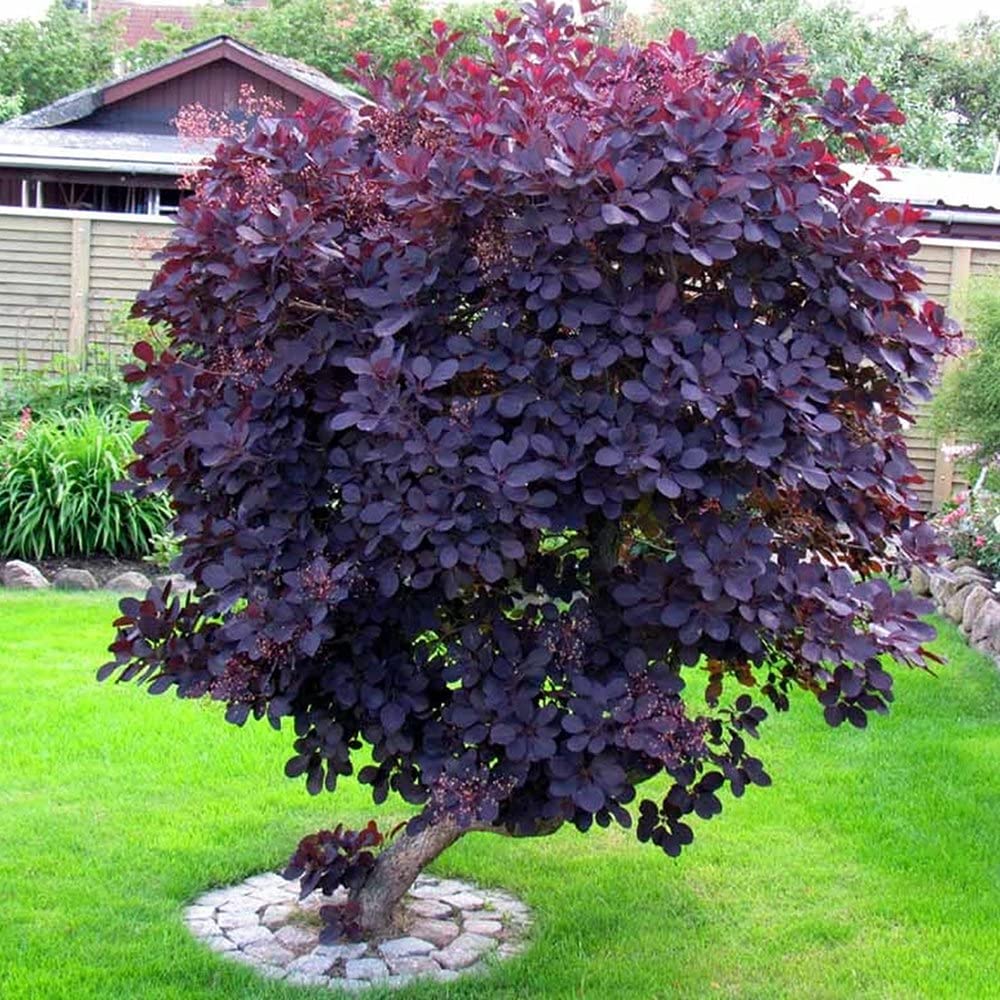
They have multiple stems and purple leaves in some cultivars and can reach 40 to 70 centimeters in height. Another characteristic is that, depending on the variety, they turn yellow, orange or purplish-red in the fall, and its name is derived from the wavy hairs attached to the flower clusters that remain in place throughout the summer, changing from smoky-pink to purplish-pink as the season progresses. As for their care, young plants should be watered deeply and regularly until they are well established.
Once this occurs the smoke bush has a good tolerance for dry conditions, in its mature stage the plants do well if moderately watered every 10 days during the active growing season. It is also important that at all times the base of the plant should be covered with wood chips or bark mulch to keep out weeds and damp soil. In part shade conditions foliage will be sparse, requiring regular pruning to keep the plants dense. On the other hand, it is advisable to fertilize it so that they grow vigorously and the leafy foliage is maintained, so nutrient-rich fertilization is essential.
Another aspect to highlight is the ease with which the propagation of the bush can be achieved, either through cuttings or seeds. If it is done from a stem, make sure it is leafy and remove the lower leaves and then bury it in a substrate so that it can easily form roots and grow a new plant. On the contrary, if it is with seeds, they should be soaked in water for a day, dried and then planted approximately 12 centimeters deep in sandy soil, after a while, it can be transplanted to a conditioned place to continue its process. Finally, it is worth noting that this plant can be affected by the invasion of pests such as the leafroller and the Verticillium fungus.
purple basil
Basil is a very popular herb with violet-hued foliage with a distinctive, medium-hardy to tender aroma used in a variety of food recipes, native to dry bushland in Africa and Asia. This plant requires a lot of heat to thrive, however there are many varieties to choose from, some of which have been planted to withstand colder conditions. They are prone to downy mildew and whitefly, which is why they usually accompany tomato fields to deter this last plague.
Basil Crimson King is a variety with strong, uniform purple leaves. They can be propagated by sowing the seeds indoors in a greenhouse or on a warm windowsill, then moving the plant outside for the summer. It is essential to water them in moderation, preferably before noon so that the roots have time to dry before the temperatures drop at night, as well as to collect the leaves frequently and remove the flowers to concentrate the energy of the plant in the unique production of foliage.
Being a humid plant, its watering will depend on the time of year to know the amount of water, generally 1 or 2 times a day to prevent it from wilting. It is also important to keep the substrate fertile, so it is advisable to fertilize it naturally every month and harvest the leaves frequently to reactivate its growth. This variety of plants with long purple leaves reproduce very quickly and you will always have them available. To propagate it, it is necessary to prepare the seedbeds, if it is a tray the size must be at least 3 or 4 centimeters.
If you decide to use a pot, it should be about 12 centimeters in diameter to prevent the plants from germinating too close together. Then, it is convenient to use moistened vegetable mulch and one or two seeds for each division without crushing the soil, to later cover and place next to a window or another place where it receives sunlight, providing water daily. When the first leaves appear, remove the plastic and continue moistening until the plants have grown a few centimeters to be able to transplant them. They can also be grown with cuttings that are placed in a container with water until they develop roots and are suitable for transplanting into the final container or pot.
Ti plant (Cordyline Fruticosa)
A graceful purplish-red houseplant featuring flamboyantly colored oblong foliage, it is a perfect choice for adding a touch of colour, style and drama to a well-lit corner of the room. Most varieties have strip-shaped leaves variegated with brilliant stripes of different colors of hot pink, white, cream, or deeper shades of purple. Cordyline fruticosa is picky about sunlight and likes to be in a spot that gets partial sun.
Ti plants are mainly indoor, there are many varieties in every combination of purple, black, lime, pink, orange, as well as different shapes and sizes, some have thin leaves, others wide, small leaves, among other attributes. This vegetation has the advantage that it can be adapted to any planting scheme. They measure from one to two meters in height and half a meter in width. These plants with long, purple leaves produce roots that often establish themselves in gardens quickly. They are grown in a full shade position on a free flowing substrate.
After planting, mulch and water regularly until set, then sparingly. Cordylines are hardy and tolerate periods of sun, although they prefer filtered light. As part of the care required, is the removal of faded foliage, spring being the ideal season to do it or when they are infected by a pest. Consideration should also be given to applying liquid fertilizers after prolonged dry periods and every 3 months to enhance purple foliage. By cutting all the foliage the plant will regrow from the stem.

The reproduction of this vegetation occurs by cutting and its subsequent planting of the extracted stems in another part of the garden or in pots so that the propagation results. Just be sure to provide them with the vital liquid in the first 2-3 months and avoid exposing them to direct sunlight. It is worth noting that its cut leaves have many uses, particularly in decoration and cooking when used as centerpieces or room arrangements, the leaves can even be used as wrappers or decorations for culinary dishes, although they are not edible.
heuchera
They are generally found in gardens where they are noted for their variegated purple leaves combined with hot pink, but require measures when planted in containers to prevent vine weevil infection, however this can be a minor problem. concern when planted in open ground and the plants do well in sun or shade to add dramatic color to the garden, whose brilliant coloration shows best in spring. In addition to this, they require moist clayey soils that drain well.
Coral bells are native to the forests of North America, tend to grow in dense clumps, have brightly colored foliage, which is why they are primarily cultivated, and because of the summer blooms that add to their summer charm. A compact, mounding plant with glossy, purplish-black leaves, they're perfect for growing in front of a shady border or in vases on the patio. Its great color is further highlighted when masses of small cream-colored flowers are born on tall stems in the months of June to September.
They do best in part shade, especially in warmer climates. The color can fade in direct sunlight, with the consequence that too much heat and light can burn the leaves, but this can be avoided by watering the plant regularly, especially as the shallow roots will need extra moisture on hot sunny days. On the other hand, it is important to know that bell corals planted in damp shade can be prone to fungal diseases. If your plants start to have problems, it is best to move them to a drier site.
purple knight
This dark tropical foliage plant is best adapted to heat and suitable for edging, as an annual groundcover or in a formal knot garden, importantly its deep purple leaves can contrast with brightly colored flowers or foliage anywhere. The Alternanthera are native to tropical and subtropical areas of Central and South America, their flowers are generally an afterthought. Its ruby-purple foliage, which is almost black, performs well in high temperatures, where its color deepens and becomes shinier.
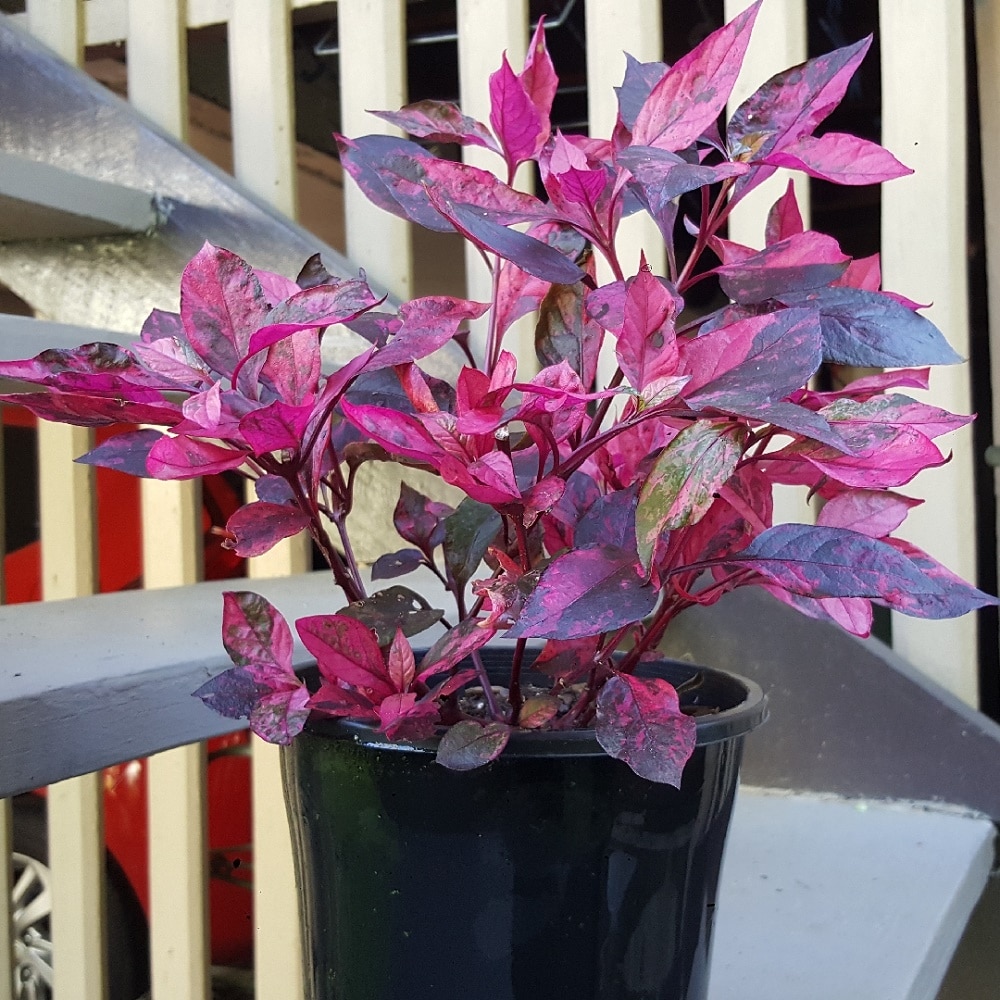
This genus is easy to grow from seed, taking care to plant it after the frost season in moist, well-drained soil in full sun to ensure more colour, or they can be grown in partial shade. The seeds should be sown at a temperature of 12 to 18 degrees as soon as they are ripe or in the spring so that the seedlings can vary in color. To multiply it, this can also be done by separating the cuttings at the end of summer. Another aspect to consider is that for this annual plant, mites and Fusarium wilt represent a great risk that must be combated as soon as they are detected to avoid further damage.
Bark of nine (Physocarpus opulifolius)
As a versatile deciduous flowering shrub, it is widely used in landscaping. It gets its name from its bark, which can be separated into nine thin layers. It has purple leaves in some of its versions, as well as the traditional dark green or reddish green in other presentations. It blooms in late spring with clusters of white or pink flowers, and produces red berries in late summer and fall that often attract birds. It is available in many sizes, with a mature height ranging from 1,5 to 3 meters tall. There are also dwarf varieties that reach less than a meter in height.
For sowing, the roots are placed up to where the earth covers them so that they remain at the level of the substrate, filling and compacting the alkaline or acid soil with good drainage. Mulching the base is necessary for moisture retention and weed control. Because its natural habitat includes stream banks, hillsides, and moist scrub, accepting loamy and loamy soils, as well as shallow rocky soil, it is one of the low-watering, long-leaved purple-leaved plants.
Between March and June, it is the best period to lightly fertilize a shrub of this type with compost and organic fertilizer prepared for this type of vegetation. Apply the fertilizer to the soil starting a few inches from its trunk and toward the end of its branches. On the other hand, cut after flowering or before mid-August to keep the shape and thin the branches. Older shrubs can be pruned close to the ground during the winter to renew the plant and promote more leaf and flower growth.
In this type of woody propagating plant, cuttings should be taken when the plant is dormant, following the steps below: First cut several pieces of hardwood branch in late fall or early summer. Winter, about 1 centimeter thick and 10 to 15 centimeters long. Each cut should have at least 2 knots, to cut below and above these overhanging branches. Then dip the bottom of each cutting in rooting hormone, collect the cuttings, and secure with a rubber band.
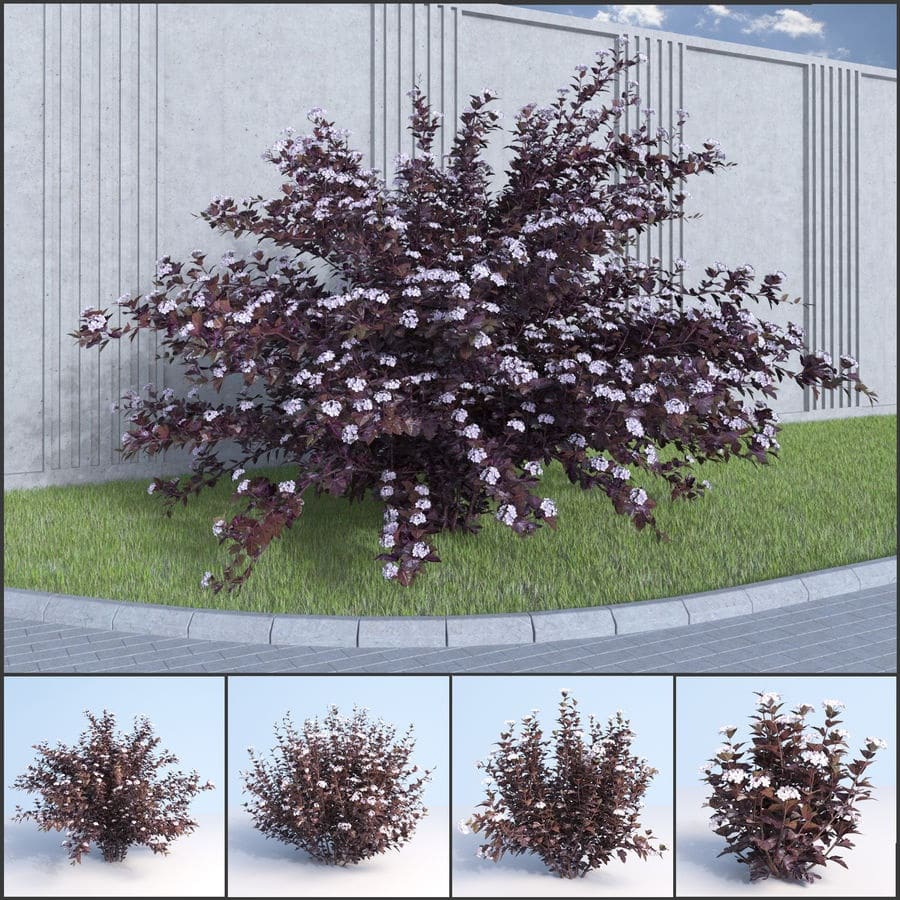
Subsequently, it must be placed in a bag and refrigerated, so that in the spring they begin to take root to be ready for transfer to the place of growth. The nine-bark shrub has varieties with leaves of different colors, usually purple and yellow. Among these is Mindina or Coppertina, which features coppery-purple foliage that matures to a reddish-purple. Also, the so-called Seward or Summerwine whose compact leaves are purple. And the famous Center Glow, which has leaves with a golden yellow center surrounded by purple.
Arce Japanese (Acer palmatum)
The well-known Japanese maple has among its various presentations a purple one, called Acer palmatum Wolff or Emperador I, which is cultivable in a place protected from strong winds and semi-shaded. In the months of September to December the leaves turn a resplendent purplish-red before falling to cover the ground in wonderful colour. They are slow growing plants suitable for gardens and smaller containers.
It can vary from shrub to small tree, its average size is 4-7 meters in height and its shape is usually round. They are grown in partial shade and in moist, well-drained clay soil, which prevents the substrate from having high alkalinity. The easiest way to regulate the moisture level of the soil surrounding a Japanese Maple tree is to apply mulch, and it should be watered whenever the soil is dry, especially when there hasn't been much rain. For its part, fertilization is carried out at the end of winter or at the beginning of spring after one year of age. You can also re-feed it in the summer if necessary.
They can be propagated through seeds or softwood cuttings. These plants with long purple leaves do not require a lot of pruning, just remove the branches that have crossed to improve appearance and those that are damaged to activate their growth. On the other hand, they can face problems caused by pests such as aphids, scales and beetles, in addition, they can present burns, bark cutting, verticillium wilt, leaf spots and manganese deficiency, among others.
velvet plant (Gynura aurantiaca)
It is a fast-growing perennial herb, so soon after planting it becomes a beautiful bushy plant with purple, hairy leaves that are up to six inches long. When blooming, the red and yellow flowers should be removed as they give off a strong odor that is unpleasant for many. Its maintenance is very simple, you just need a sunny place, enough water and a regular diet. To maintain its beautiful colour, the substrate must have good fluidity, the leaves must not be sprayed, as the smooth surface will retain water and increase the risk of fungal infection.
This is another of the plants with long purple leaves that offer the possibility of multiplying easily through their stem cuttings, which must measure 7 centimeters with several leaf nodes, then they will be inserted in the potting soil and will remain covered to guarantee adequate humidity. and the successful rooting to proceed once the seedlings are born to the due transplant so that the new velvety plants develop.
Another element to pay attention to in the evolution of this plant is that they are susceptible to aphids that are attracted to the stems, mites and scales, which can be treated with a good pesticide in serious infestations or simply cleaned with a damp cloth if you manage to catch them early.
Rex begonia (Begonia rex-cultorum)
Within the classification of plants with long purple leaves, this variety is one of those that is best adapted to growing indoors, despite the fact that its flowering and size of its flowers are not as showy as its leaves. But precisely, its attraction is its exuberant foliage that presents jagged, serrated and lobed edges with colors that include violet, green, red to pink, accompanied by silver tones and mixed with each other in various ways. Among the various types that exist, Begonia rex is one of the most beautiful plants, they are also called painted leaf begonias or fancy leaf begonias up to 15 centimeters long.
Since it is a leafy plant, careful cultivation is important to bring out all its beauty. You can do this by using porous potting soil in a relatively shallow container and feeding it regularly. Take care to keep the plant moist and avoid overwatering. Be careful not to spray the leaves directly, as standing water will promote powdery mildew, which is a problem for a plant grown for its beautiful foliage. Another of the suitable conditions for the best coloration is that they have daytime temperatures of 21 degrees Celsius and night temperatures around 15 degrees.
Provide the plant with indirect sunlight and turn it frequently to expose it to the same light on all sides. It is important to mention that they do not tolerate very cold climates and in winter this presents a period of rest and they can lose their leaves, which if the plant is healthy it will recover quickly. They can also be very easily propagated by dividing the rhizome during the summer season. For these cuttings to work they must have at least one main vein, these must be placed in the substrate for new plants to grow.
Subsequently, it is best to transplant it into large, relatively shallow pots to give the rhizome room to spread. However, when the rhizome begins to overflow the sides of the pot, it's time to repeat the process of transplanting it into a new container with fresh soil to increase your plant stock. As with all begonias, do not overwater the soil of newly potted plants, but keep it slightly moist and warm.
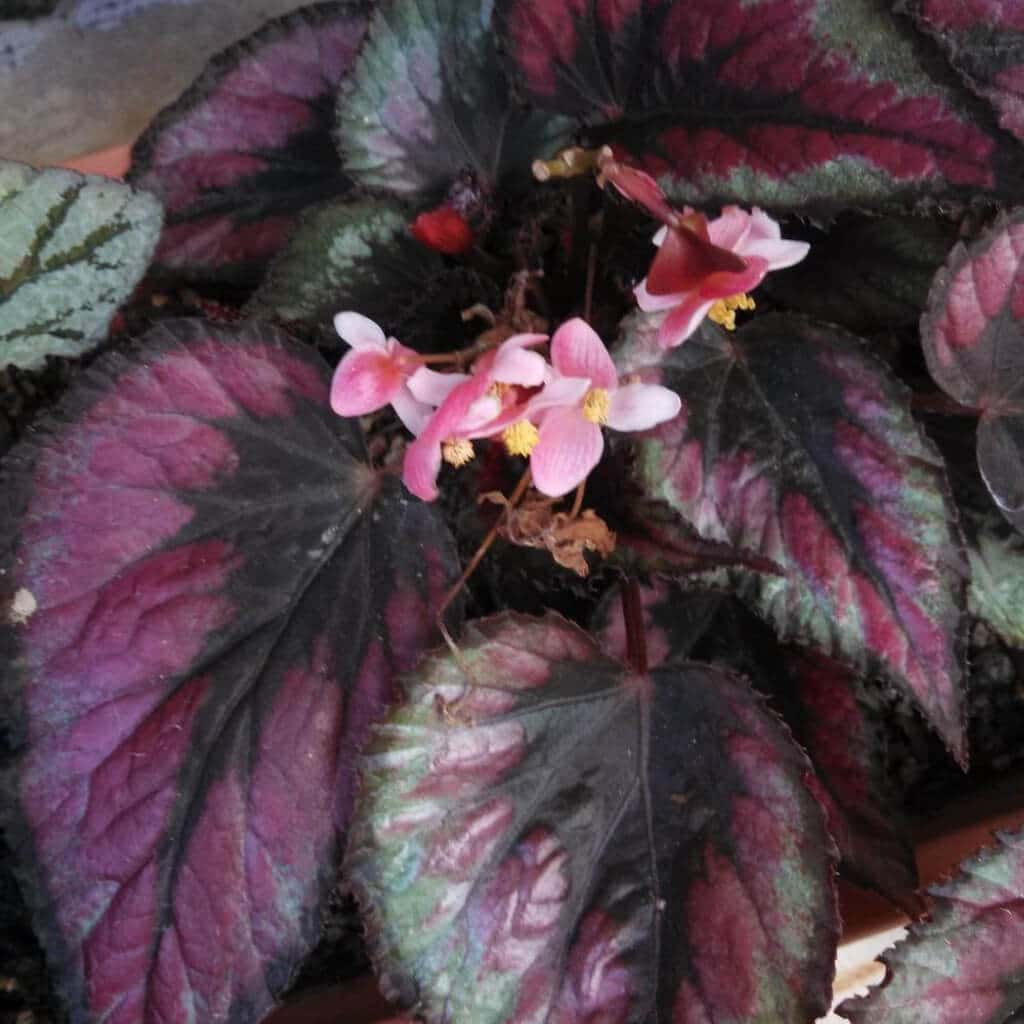
This type of long purple leafed plants can also be propagated by fixing a leaf to the bedding mixture and making small incisions in the veins of the leaves or by inserting a leaf with a petiole directly into the soil, i.e. the petiole is the stem. that attaches the leaf blade to the stem of the plant. Also, these plants are often affected by pests such as fungal botrytis. A systemic fungicide can help combat it. It is also important that you remove dead leaves promptly and ensure good air circulation. Similarly, mealybugs become a common problem, so they must be prevented by pruning the plant well.
Waffles (Hemigraphis colorata)
It is a herbaceous plant from Southeast Asia, it has oval, pointed leaves about 4-6 cm long with jagged edges and a fantastic purple color on the back and purple-green on the front. The roots come out in the lower nodes. They can be planted in gardens or containers to give their purple cascading foliage, perfect for mixed landscape designers. This plant is also known as red ivy and it grows easily indoors under the right growing conditions. In principle, it is required that the plant be illuminated, but that direct sunlight does not reach the foliage as it can damage it by discoloring or burning its leaves.
Another necessary condition is to have a uniformly humid soil, with constant irrigation and well drained, to favor the growth and well-being of the plant. High humidity is an integral part of ivy plant care. Spray the plant regularly and use a pebble tray to provide it. With some frequency carry out a propagation using stem cuttings, this consists of choosing stem pieces of 10 to 15 centimeters, from which all the leaves will be removed except the upper ones and placed in small containers in a moist substrate.
Fertilize long purple leafed plants with a liquid houseplant food or granular fertilizer. Water as needed to keep the soil moist, with this process you will have rooted cuttings ready to transplant in 7-10 days. Once the plant is established it should be pruned frequently as it grows quickly. Diseased, weak, or dry stems are cut with pruning shears that have been disinfected with alcohol in late winter or fall to control their growth.
Ivy pests are varied, among which are green aphids, which are pests that feed on sap and stems, they can also attack flowers, yellow chromatic traps can be used, because the color attracts their attention and there they get trapped. There are also red spider mites, which are small mites that feed on the cells of the plant, these are evidenced by the cobwebs that form between the leaves, but they can be easily eliminated with insecticides.

Caladium (Caladium X hortulanum)
Caladiums are tropical perennials that have showy foliage and can be grown indoors, but can also be grown outdoors, whatever their location they need to receive a minimum of 3-4 hours of filtered light each day. . They have large, slender leaves that look like arrows and hearts, and are found in an amazing variety of colors and patterns in purple, red, pink, and cream that are mottled, veined, and striped. They can easily give you the visual impact of flowers while they are just foliage plants.
It is important to consider that this plant has tuberous roots and that its foliage grows from spring to autumn. They also require very high humidity, do not tolerate cold, and are toxic to animals and humans. They are also seasonal plants even in the tropics, where gardeners plant them in the spring and summer months so they thrive in heat and humidity. When grown indoors, they do best in high heat, bright but indirect light, and high humidity. Even in the best conditions the leaves last only a few months before they start to die back and the plant goes dormant again, when this happens you can bag the tubers and replant them next year.
While these long purple leafed plants are grown for their foliage, they also produce flowers, which begin in the form of spathes or spikes, which are often removed as soon as they appear as a measure to ensure that all of the plant's energy is used. concentrate for the development of its extraordinary leaves. Also, it's good to know that the narrower the leaves, the more sun they can take and growing them outdoors in containers gives you more control over light conditions. Plant caladium in a rich, well-draining potting mix, such as a moist mix of soil and peat.
Garden soil should also be rich and well-draining, with an ideal slightly acidic pH of 5,5 to 6,2. When leaves appear on the plant, water as needed to keep the soil evenly moist and prevent the plant from drying out. In the event that the leaves begin to wither, it will be necessary to stop watering the plant and resume it when the foliage appears again the following season. In turn, it is advisable to fertilize the plant weekly during the growing season, either in liquid or in slow-release granules.
The warmer the temperature, the better for indoor plants, it is recommended that it be at 21 degrees Celsius, because at this level the tubers begin to grow. Also, the humidity should be kept as high as possible. When planting outdoors, you can transplant the tubers into pots or transfer them to peat pots at the end of the last frost date. Plants grown this way should be started indoors four to six weeks before transplanting.
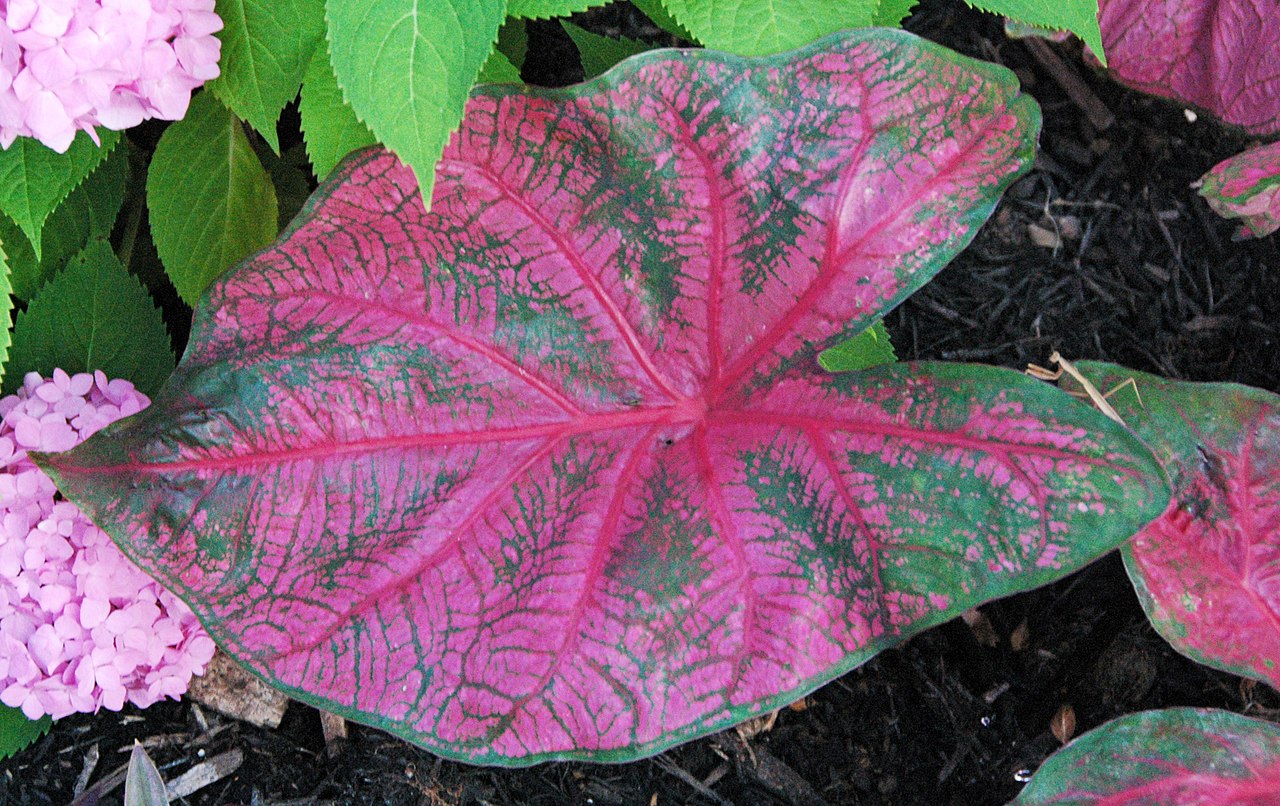
In this sense, the mature tubers can then be divided, ensuring that each new section of tubers has at least one growing site. Indoors or out, these long purple-leafed plants are seasonal, with foliage in summer and a rest period in fall or winter. Its dormant period is not determined by temperature or light cycle, but by how long the plant has been growing. After the leaves begin to die back in the fall, keep the tubers in the same pot or remove, clean, and place in sawdust or sand for storage. Store above 12 degrees Celsius to minimize loss of healthy samples. Plant them again when the next growing season begins.
Coleus (Coleus blumei)
Below, we present all the relevant information about another of the long purple leaf plants, which is characterized by having abundant leaves and providing color during all seasons in full sun and shade and are the best low-maintenance plant. Coleus is a tender tropical plant that grows perfectly both indoors and outdoors and can reach up to one meter in height. Due to their accentuated and vivid purple, yellow, green and scarlet colours, they are very popular in gardening and ornamental creations due to the curly and elongated shape of the leaves.
This plant has been in cultivation for many years and its name used by the specialists in its study has been reassigned several times. Most sources now label these plants as Plectranthus scuttellariodes, but they were additionally known in the past as Solenostemon scutellarioides and also as Coleus blumei. However, it should be noted that there is another recent proposal to reassign the group to Coleus scutellarioides. Therefore, you may see this plant labeled in commerce under any of these Latin names.
Coleus plants are not frost tolerant, so wait until temperatures stay reliably above 16 degrees Celsius before moving them into the garden. They will do best in rich, loose soil, so amending with compost or peat before planting is recommended, unless you have very good soil. On the other hand, it can be said, that in hot and dry areas, all types will need some shade, especially in the afternoon. In cooler, shorter-season areas, Shadow Coleus will need more sun exposure to help it warm up.
Prefers loose, rich, and consistently moist soil. Before planting, amend the soil with compost or other organic material. For potted plants, any good quality peat-based potting mix will work well. Coleus plants grow best in consistently moist, though not soggy, soil. The soil shouldn't stay wet all the time, but prolonged periods of dryness will slow plant growth and the leaves will start to turn brown around the edges.

Mulch will help the soil retain moisture longer, but don't use cedar mulch, which can be toxic to coleus. Also, don't let the mulch touch the stems, as it can promote rot and hide slugs. This containerized plant may need watering twice a day during hot weather. If you have rich soil, you may not need to feed Coleus plants at all. If you have poor soil, use a balanced fertilizer mixed at half strength monthly. You will get the best color from your Coleus leaves if you use the fertilizer carefully.
For full, bushy plants, pinch off the growing tips when the plants are about 15 inches tall. You can do this a few more times if you like, but after the plants start sending flower stalks, you can pinch these stalks and get the same results as pinching the tips. Additionally, it is good to know that they can be easily propagated by taking stem cuttings and rooting them. Cut a 10- to 15-inch stem tip, then remove all the leaves from the bottom half of the cutting.
Dip the stem end in rooting compound, then plant it in moist potting mix so the soil covers the exposed leaf nodes. Place the container in a plastic bag, making sure it does not touch the cut. Place the covered cutting in a bright, warm spot until new roots develop, this takes two to three weeks. Remove the plastic and continue to grow the new plant in a bright, warm spot. Modern coleus varieties sold in stores are hybrids that are almost always grown from cuttings in pots for sale at the nursery, but you can still find seeds of different types.
If you're going to grow these long purple-leafed plants in the garden outdoors, start them indoors 8 to 10 weeks before the last frost date. Lightly water the tiny seeds over a tray filled with potting mix, then cover lightly with a sprinkling of soil. Cover the tray with plastic and place it in a bright, warm spot until the seedlings emerge, which takes about two weeks. Remove the plastic and continue to grow the seedlings while keeping the soil moist, for later transplanting.
Coleus is generally not affected by disease unless the weather turns cool and humid. If that happens, expect to see signs of fungal diseases like mold. If you're growing your long purple leaf plants indoors, watch out for scale, whiteflies, and especially mealybugs. Lastly, it is normally used as an annual bedding plant or in outdoor container gardens and baskets, additionally, in warmer areas Coleus can be grown as perennial garden plants, where it can grow to resemble small shrubs with thick woody stems. .

Purple leaves on other crops due to nutrient deficiencies
Some experts point out that the purplish foliage that some cornfields have is due to dry soils, low temperatures and insufficient levels of phosphorus in the soil during their growth. Therefore, knowing that said coloration is determined by the pigment that is formed when there are more sugars in the leaves than the plants can use, then a low concentration of the reference nutrient makes it difficult for the sugars to move out of the leaves. In addition, it can be caused because in a dry and cold soil the roots stop growing and the transfer of carbohydrates to the root system stops, so both conditions cause the leaves to acquire a purple color.
In this sense, the care that must be given to the soil is of great interest, since during planting, if it is not handled properly, it can become compacted and compromise root growth. And if there is excess watering, this process will need to be reversed so that they return to their normal greenness, allowing the soil with excess moisture to begin to dry out. But if it is a genetic strain that naturally produces this purple pigmentation, crop yield will not be affected.
On the other hand, it can be pointed out that it is possible that some plantations show a discoloration of the green color of their leaves due to various factors such as poor soils, poor drainage, damage by insects and diseases, or due to nutrients such as magnesium, calcium, potassium . , and lack of nitrogen, among others, to which plants react in various ways, showing purple spots on their foliage. Foliar problems of this type are common and can cause delayed growth and presentation.
If you liked this article about Long Purple Leaves Plants, we invite you to read other articles that contain topics of interest in the following links: